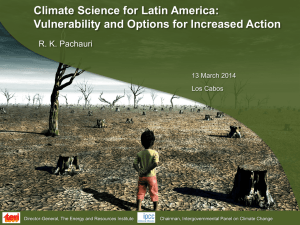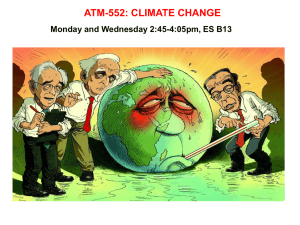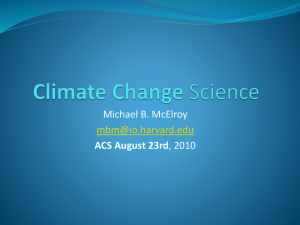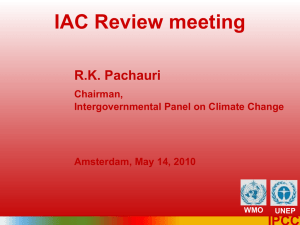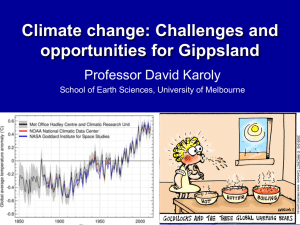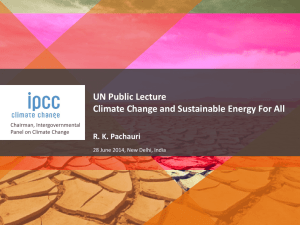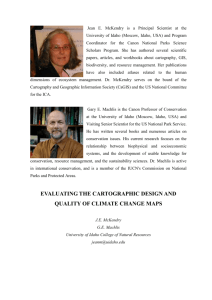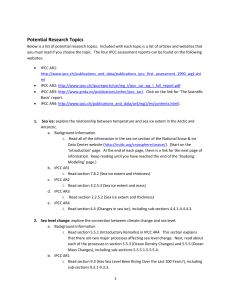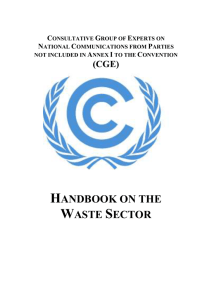Cities are major contributors of CO2 emissions
advertisement
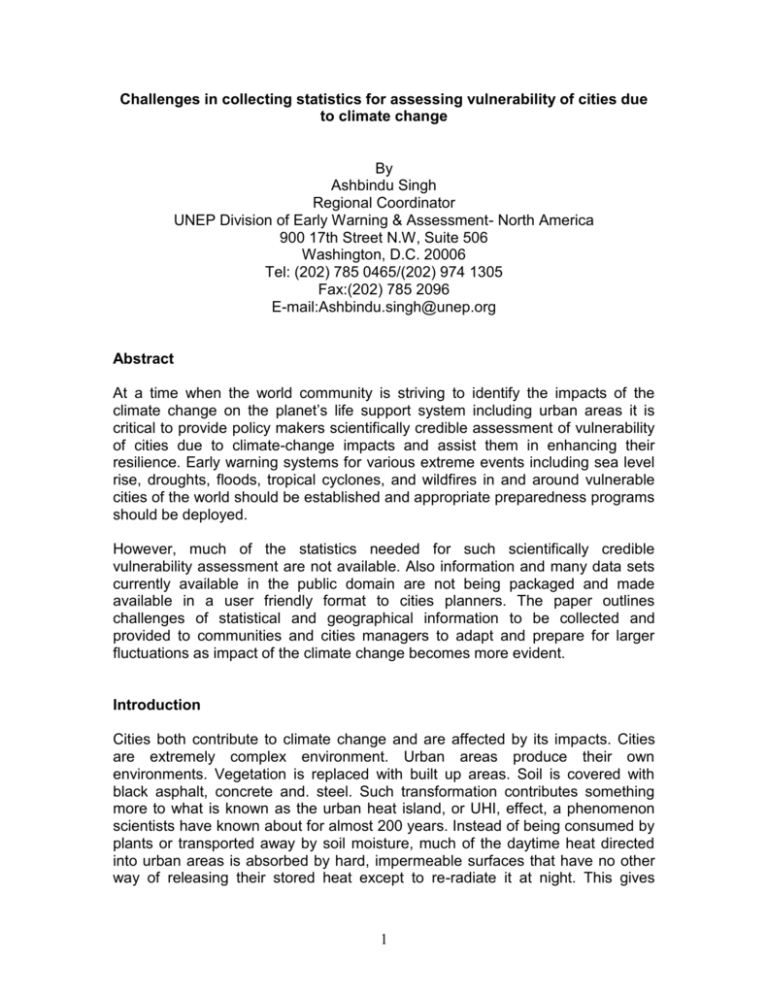
Challenges in collecting statistics for assessing vulnerability of cities due to climate change By Ashbindu Singh Regional Coordinator UNEP Division of Early Warning & Assessment- North America 900 17th Street N.W, Suite 506 Washington, D.C. 20006 Tel: (202) 785 0465/(202) 974 1305 Fax:(202) 785 2096 E-mail:Ashbindu.singh@unep.org Abstract At a time when the world community is striving to identify the impacts of the climate change on the planet’s life support system including urban areas it is critical to provide policy makers scientifically credible assessment of vulnerability of cities due to climate-change impacts and assist them in enhancing their resilience. Early warning systems for various extreme events including sea level rise, droughts, floods, tropical cyclones, and wildfires in and around vulnerable cities of the world should be established and appropriate preparedness programs should be deployed. However, much of the statistics needed for such scientifically credible vulnerability assessment are not available. Also information and many data sets currently available in the public domain are not being packaged and made available in a user friendly format to cities planners. The paper outlines challenges of statistical and geographical information to be collected and provided to communities and cities managers to adapt and prepare for larger fluctuations as impact of the climate change becomes more evident. Introduction Cities both contribute to climate change and are affected by its impacts. Cities are extremely complex environment. Urban areas produce their own environments. Vegetation is replaced with built up areas. Soil is covered with black asphalt, concrete and. steel. Such transformation contributes something more to what is known as the urban heat island, or UHI, effect, a phenomenon scientists have known about for almost 200 years. Instead of being consumed by plants or transported away by soil moisture, much of the daytime heat directed into urban areas is absorbed by hard, impermeable surfaces that have no other way of releasing their stored heat except to re-radiate it at night. This gives 1 residents of urban areas little relief from the summer heat long after the sun sets. This stored heat will only get worse with increased global warming Among the health risks associated with heat waves are heat exhaustion and heat stroke. Symptoms can include vomiting, diarrhea and fatigue. The most vulnerable include infants and children, pregnant women and elderly people with chronic medical conditions. Outdoor workers and people living in poverty are also at risk. According to an OECD study (www.oecd.org) Cities are major contributors of CO2 emissions. They are home to more than 50% of world population and 2/3 of total energy use worldwide – and that share is growing. Urbanisation is a driver of changes in per-capita and total greenhouse gas emissions worldwide. Urban populations and infrastructure are vulnerable to climate change. Half of humanity now lives in cities. This will increase to 60 per cent within two decades. Coastal cities are particularly exposed to rising sea levels and storm surges due to climate change (e.g. compared to today’s levels of exposure, a 50-cm sea level rise by 2070 could expose three times as many people and ten times as many assets to coastal flooding in large global port cities). Urban heat island effects will exacerbate the effects of global warming in all cities. The poorest populations will be more affected as they have fewer resources to respond Connecting climate change science with policy Climate change is one of the gravest problems of our time. However, concerns about climate change have been primarily raised by scientific community. The Intergovernmental Panel on Climate Change (IPCC) is the leading body for the assessment of climate change, established by the United Nations Environment Programme (UNEP) and the World Meteorological Organization (WMO) to provide the world with a clear scientific view on the current state of climate change and its potential environmental and socio-economic consequences. The IPCC is a scientific body. It reviews and assesses the most recent scientific, technical and socio-economic information produced worldwide relevant to the understanding of climate change. It does not conduct any research nor does it monitor climate related data or parameters. Thousands of scientists from all over the world contribute to the work of the IPCC on a voluntary basis. Review is an essential part of the IPCC process, to ensure an objective and complete assessment of current information. Differing viewpoints existing within the scientific community are reflected in the IPCC reports. The IPCC is an intergovernmental body, and it is open to all member countries of UN and WMO. Governments are involved in the IPCC work as they can participate in the review process and in the IPCC plenary sessions, where main decisions about the IPCC workprogramme are taken and reports are accepted, adopted and approved. The IPCC Bureau and Chairperson are also elected in the plenary sessions. Because of its scientific and intergovernmental nature, the IPCC embodies a unique opportunity to provide rigorous and balanced scientific information to decision 2 makers. By endorsing the IPCC reports, governments acknowledge the authority of their scientific content. The work of the organization is therefore policy-relevant and yet policy-neutral, never policy-prescriptive. The IPCC Working Group I (WG I) assesses the physical scientific aspects of the climate system and climate change. The main topics assessed by WG I include: changes in greenhouse gases and aerosols in the atmosphere; observed changes in air, land and ocean temperatures, rainfall, glaciers and ice sheets, oceans and sea level; historical and paleoclimatic perspective on climate change; biogeochemistry, carbon cycle, gases and aerosols; satellite data and other data; climate models; climate projections, causes and attribution of climate change. The IPCC Working Group II (WG II) assesses the vulnerability of socio-economic and natural systems to climate change, negative and positive consequences of climate change, and options for adapting to it. It also takes into consideration the inter-relationship between vulnerability, adaptation and sustainable development. The assessed information is considered by sectors (water resources; ecosystems; food & forests; coastal systems; industry; human health) and regions (Africa; Asia; Australia & New Zealand; Europe; Latin America; North America; Polar Regions; Small Islands). The IPCC Working Group III (WG III) assesses options for mitigating climate change through limiting or preventing greenhouse gas emissions and enhancing activities that remove them from the atmosphere. The main economic sectors are taken into account, both in a near-term and in a long-term perspective. The sectors include energy, transport, buildings, industry, agriculture, forestry, waste management. The WG analyses the costs and benefits of the different approaches to mitigation, considering also the available instruments and policy measures. The approach is more and more solutionoriented. The Task Force on National Greenhouse Gas Inventories (TFI) was established by the IPCC to oversee the IPCC National Greenhouse Gas Inventories Programme (IPCC-NGGIP). The core activity is to develop and refine an internationally-agreed methodology and software for the calculation and reporting of national GHG emissions and removals and to encourage its use by countries participating in the IPCC and by parties of the United Nations Framework Convention on Climate Change (UNFCCC). The NGGIP also established and maintains an Emission Factor Database. 3 The Task Group on Data and Scenario Support for Impacts and Climate Analysis (TGICA) was established to facilitate co-operation between the climate modeling and climate impacts assessment communities. It aims at facilitating wide availability of climate change related data and scenarios for climate analysis and impacts, adaptation, vulnerability, and mitigation research. The TGICA does not develop itself any emission, climate, or other types of scenarios, not does it make any decision regarding the choice of scenarios in the preparation of the IPCC reports. It does not undertake any modeling or research. One of its main activities is the coordination and oversight of the IPCC Data Distribution Centre (DDC), which provides timely information and data to the international climate research community, in particular consistent data sets and guidance material. Challenges and Opportunities for Official Statistics The global official statistics community presently engages the issues of climate change as a provider of some the data sets used by scientists. Some national statistical offices are heavily engaged and provide all official estimates required in the monitoring efforts. Some engage only in analytical efforts, principally to investigate the effects of mitigation protocols on national economy or the impact of climate change in planning scenarios. Many others have no activities at all related to this topic. There is a need to highlight how official statistics can contribute to the measurement and monitoring of the different aspects of climate change. The impacts of and adaptation to climate change are very important in developing countries and statistics that describe these aspects have to be developed for regular national reporting and analysis. There is a general need for timelily, more frequent (e.g. quarterly, seasonal) data. The need for georeferenced and spatially disaggregated data is very important, underlying the importance of spatial analysis. To meet the demands for more and new Statistics the community has to work in an innovative ways undertake new surveys, collect more data and communicate using the latest information and communication technologies in a compelling fashion to make impact.. Some of the challenges for official statistics are to:• • • • To collect relevant data on a regular basis and conduct statistical analysis to inform policy makers and public on climate change issues Undertake Greenhouse gas emission calculations as part of official statistics Define role of official statistics in the measurement of the impacts of, vulnerability and adaptation to climate change Contribute towards Carbon emission trading and other mitigation strategies 4

